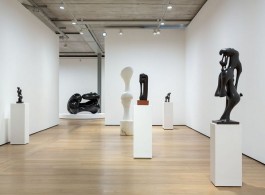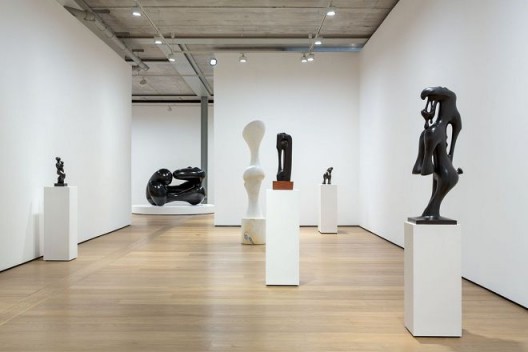Almine Rech Gallery, London
All of which is to say that Cárdenas arrived in France not as some unformed, marginal or alien other (albeit his work was absolutely unknown in Europe at the time of his arrival in Paris), but as an artist who had already absorbed the influences of a wide-ranging collection of indigenous, colonial and colonised cultures: he was the prototype of today’s global citizen. And in this sense he was as modern as Notre Dame du Haut or the fastest electric train.
However, despite the mix of cultures to which the artist was exposed in Cuba, early works, such as the bronze sculpture La Negra (1947), created during the period of Cárdenas’s studies, demonstrate that the synthesis of ethnic subjectivities, classical form and more contemporary elastic lines was as much a struggle as it was harmonious: in La Negra each of these elements is distinguishable precisely because it is not completely (or, in aesthetic terms, invisibly) integrated with the others. In this way, the work can be seen to reveal the ways in which such a mix – a combination of aesthetics (classical pose, a physiognomy that was then celebrated for its connections to ‘primitive’ and African sculpture and flowing limbs suggestive of fluid form) that parallels the mixture of influences from which Cuban national identity was being assembled – is constructed rather than innate. Three years later, these tendencies would be more clearly revealed, and to some extent resolved, in the bronze La Femme au Chewing Gum, in which the more essentialised biomorphic forms that would characterise Cárdenas’s later work start to emerge. In La Femme au Chewing Gum a woman uses her body to sculpt the gum, just as her body has been formed by the body of the artist: she is at once subject and object. Her voluminous form is captured in an instant of extreme shapeliness and just as extreme shapelessness as she steps forward into a moment suggestive of self-consciousness, self-creation and self-identity: the gum that stretches from her hand to her mouth proposes the whole to be an ouroboros – a subject to which the artist returned in works such as Fer à repasser (1956) – constantly shaping and reshaping itself, consuming and excreting in a primal flow that is an endless loop of creation. In many ways, La Femme au Chewing Gum (whose form and flow would also find direct echoes in works such as the 1974 abstract bronze Bouba, for example, or the 1979 Fleur éveillée) sets out the series of material and intellectual concerns that Cárdenas would work with for the rest of his long career.
The Paris of which Cárdenas was now a part was one in which Pan-African, négritude1 and anticolonial movements were beginning to flourish. Indeed, despite the cosmopolitan influences of his formative years, Cárdenas would note that it was here that he first became truly conscious of his négritude. The First Conference of Negro Writers and Artists (staged to promote both the cultural independence of African cultures and their coexistence with the West) took place in Paris in September 1956 and resolved that ‘artists, writers, scholars, theologians, thinkers and technicians participate in the historic task of unearthing, rehabilitating and developing [Negro] cultures so as to facilitate their being integrated into the general body of world cultures’2. At the conference, the Martiniquais poet (and both theoriser of decolonisation and founding father of the négritude movement) Aimé Césaire imagined a ‘new civilization’ that would ‘owe something to Europe and to native civilization’3. To an extent, Cárdenas was the perfect embodiment of this vision, although ‘native civilisation’ should properly be pluralised in his case, to encompass both Native American and African influences. Given that, it is no surprise that Cárdenas’s contemporary and Césaire’s countryman, the poet Édouard Glissant (for whom Césaire had been an important inspiration) became one of the Cuban’s great champions. ‘It’s not enough to say that Cárdenas is Cuban, of American stock…’ Glissant wrote, attempting to parse the artist’s complex heritage, elsewhere asking viewers to marvel at ‘how he assembles the memory of the future’4.
Yet, however much Cárdenas was ahead of his time, it was a key figure from art’s recent past, André Breton, anticolonialist and celebrated founder of Surrealism, who became one of the Cuban’s most prominent champions. Shortly after the latter’s arrival in Paris, Breton invited Cárdenas to participate in a Surrealist exhibition (the first of several in which the artist took part) at L’Étoile scellée gallery in 1956. In the Cuban’s work, the Frenchman saw a reconnection between human hand and the ‘hand’ of nature in an age of increasing industrialisation and commercialisation, and he saw a relation between materials and ideas that allowed an almost animist magic to persist in a world of utility and functionality: an age dominated by what Breton described as ‘the monster of technological progress’5. There is a sense, of course, that Breton’s view of Cárdenas is encased within the Frenchman’s own agendas and cultural relativism, in which a sense of both the exotic and what was then called ‘the primitive’ (key to Cárdenas work is that there is no such dichotomy between ‘primitive’ and ‘modern’, however much elements of both may be formally traceable) play a part. Equally, there is a sense that Breton was subject to a more widespread fetish for the anthropological and ethnographical that dominated artistic practice in Europe during the early years of the twentieth century and more particularly (and problematically) as its colonial empires began to fall apart. Yet Breton’s ability to connect in these ways to the work of the younger man is also testament to the openness and universal qualities of the Cuban’s oeuvre, which would lead in turn to his work being exhibited all over the world, and to the artist working in countries as varied as Canada, Austria, Japan, Israel and Korea.
That’s not to say, of course, that Cárdenas’s work is not in conscious dialogue with art from the past or his immediate surroundings. His sculpture offers a clear formal dialogue with generation of European sculptors that includes Constantin Brancusi, Jean Arp and Henry Moore; just as much as it does with Dogon sculpture (most self-consciously in the black-marble totem Dogon, 1971) and various American traditions. The enduring interest of Cárdenas’s work is that it reflects all and none of those things at one and the same time. As José Pierre, the leading authority on Surrealism and a constant champion of Cárdenas’s work (Pierre was the first critic to write about it) wrote in 1962: ‘Cárdenas, indeed, figures among the small number of modern sculptors who, at an equal distance from academic routine and from falling into line with contemporary pictorial upheavals, have elected to inscribe their work under the sign of a fully assumed lyric decision. With them – Brancusi, Pevsner, Arp, Giacometti, Calder and a very few others – sculpture truly invents its own answers’6.
Take the totemic bronze Mon Ombre après Minuit (1963), a work that from its title through to its black and white colouring plays with notions of projected image and self-image, natural creation and human construction. The work begins with a contradictory proposition: outside of urban areas, a shadow should not exist after midnight. Even when it is present, a shadow does not admit to race or skin colour. Here we are presented with an anthropomorphic abstraction in dark metal with white areas suggestive of eyes and teeth, the whole having the appearance of a cartoon monster. The flattened figure has a stretched and etiolated biomorphic form and betrays something of the influence of Dogon sculpture, as well as that fundamental play of sculptural form – between solid and void via material manipulation. The interaction as a whole self-evidently rests on the projections and prejudices that a viewer brings to the work and then see reflected in their reading of Cárdenas’s art.
In his own reading of Cárdenas’s work, Glissant figures the artist’s plays with light and dark, solid and void as a reflection of the natural landscape (Cárdenas was also celebrated for his mastery of a variety of materials, primarily wood, metal and marble, and for his ability to create work from whatever the landscape around him provided) and its elemental forces, primarily the sun7. There’s a sense in which rather than inventing something new (which is in any case impossible from a philosophical or mathematical point of view) Cárdenas maximises the essential nature of what’s already there, be it light and shade, solid and void, a piece of wood or a marble quarry8. Furthermore, Cardenas’s mastery of the natural qualities of his materials allows the intellectual content of his sculptures to flow, mix and interact with all the seamlessness of their admittedly sensual curves and lines.
Above all else, what makes Cardenas’s work as relevant today as it was when it was first shown is its dialectical method. In formal terms works as varied as the 1981 marble Le repos de l’oiseau, the 1975 bronze Naissance, the burnt-wood totem Blanc et noir (1965) or the bronze Le coq (1974), all feature paired entities that caress or entwine with each other in ways that generations of critics have simply celebrated as masterfully ‘erotic’ or otherwise sensual (there are long discourses about the artist’s evident celebration of the ‘female form’), but which also speak to Cardenas’s more general interest in embodying a range of perspectives and influences in his work while emphasising neither contradiction nor separation. This is the memory of the future. And it’s in this sense that Cárdenas, is even today, an artist for our own age. An age in which decolonisation has become a fetish, ideas of any form of universal or global culture anathema, and in which what divides rather than unites us has a tendency to prevail. For Cárdenas authenticity is something you work to create rather than simply inherit.
Mark Rappolt
1. Leymarie, Jean, ‘Cárdenas’, Agustin Cárdenas: Desire and Grace (exh. cat. New York, 2002)
2. Legum, Colin, Pan-Africanism: A short political guide (London, 1962), p.212
3. Quoted in King, Richard H., Race, Culture and the Intellectuals, 1940–1970 (Baltimore, 2004), p.249
4. Quoted in Langui, Emile, ‘Cárdenas, sculpteur exceptionnel’, Cárdenas (exh. cat. Brussels, 1974)
5. Breton, André, untitled catalogue text from 1959, republished in Cárdenas: Sculture, 1947–1997 (Milan, 1997), p.45
6. Pierre, José, Cardenas, or Exactingness and Grace (Paris, 1962)
7. See Glissant, Edouard ‘Le monde Légendaire de Cárdenas’, 1961, republished in Cárdenas: Sculture, 1947–1997 (Milan, 1997), pp. 51-2
8. Glissant recounts the experience of watching Cárdenas creating sculpture from what he found on the ground in Martinique in Le Discours antillais (Paris, 1981), p. 448




